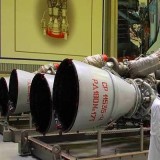Romania tests IAR-99SM light attack aircraft armed with German IRIS-T air-to-air missile

{loadposition bannertop}
{loadposition sidebarpub}
As reported by Dacian Draco on January 13, 2025, the German IRIS-T air-to-air missile has been integrated into Romania’s IAR-99SM aircraft. One of these missiles was attached to a test-bed during a visit by Stéphane Séjourné, the Vice-President of the European Commission, at the INCAS Institute in Bucharest. The Romanian Minister of Research, Innovation, and Digitalization, Bogdan Gruia Ivan, highlighted Romania’s involvement in a drone project featuring local production of optoelectronic equipment and computer systems. He also mentioned that the INCAS Institute is assisting in the creation of a Romanian-designed drone prototype.Follow Army Recognition on Google News at this link
The IAR-99 SM (Modernized Standard) program focuses on upgrading ten IAR-99 Șoim (Standard) aircraft to the SM variant to prepare Romanian pilots for operations on F-16 and F-35 fighter jets while retaining capabilities for close air support and low-speed air target engagement. (Picture source: Stefan-Radu Oprea)
The IAR-99 SM (Modernized Standard) program focuses on upgrading ten IAR-99 Șoim (Standard) aircraft to the SM variant under a 2020 contract between the Romanian Ministry of Defense and Avioane Craiova. Valued at 275 million lei, the contract originally required all ten aircraft to be delivered within four years. However, no aircraft were delivered in the first three years due to delays attributed to the COVID-19 pandemic and supply chain disruptions caused by the war in Ukraine. Testing of the first upgraded aircraft began in December 2023, with the remaining nine aircraft in various stages of repair or modernization. The program, scheduled for completion in 2024, aims to prepare Romanian pilots for operations on F-16 and F-35 fighter jets while retaining capabilities for close air support and low-speed air target engagement.
The modernization includes advanced avionics systems compatible with NATO standards, such as a head-up display, multifunctional displays, and Embedded Virtual Avionics systems. These upgrades, supplied by Elbit Systems, enhance the IAR-99SM’s role in advanced pilot training and extend its operational lifespan by 10–15 years. The aircraft are also equipped for air-to-air and air-to-ground combat, including integration with the IRIS-T missile. Additional improvements include logistical support and systems designed for training, close air support, and maintaining operational readiness. These updates aim to align the IAR-99SM with current requirements for both training and operational missions within the Romanian Air Force. The integration of the IRIS-T air-to-air missile, observed during tests in 2023, marks a significant enhancement, positioning the IAR-99SM as a versatile trainer and light attack aircraft.
Earlier attempts to upgrade the IAR-99 began in the 1990s, focusing on improving avionics and compatibility with modern systems. In 1990, a collaboration with Jaffe Aircraft Corporation introduced Honeywell avionics and a redesigned two-piece canopy, although these efforts did not result in export contracts. In 1992, the IAR-109 Swift project, developed with Lahav of Israel, included HOTAS controls, HUD systems, multifunction displays, and integration of NATO-standard weapons. However, this project was discontinued in 1994 after limited progress. In 1996, the program resumed with Elbit Systems, resulting in the IAR-99C Șoim, which incorporated avionics compatible with the MiG-21 Lancer upgrade and modern training systems. The Șoim variant first flew in 1997, with 12 units delivered to the Romanian Air Force by 2008, though fewer than originally planned.
Since its maiden flight on December 21, 1985, the IAR-99 underwent several upgrades to meet evolving operational needs, including avionics modernization and compatibility with NATO-standard systems, ensuring its continued service within the Romanian Air Force. (Picture source: Romanian Air Force)
The IAR-99 was Romania’s first jet trainer and light attack aircraft fully designed and built domestically to replace the L-29 Delfin and L-39 Albatros trainers. The project began in the 1970s, and the first prototype conducted its maiden flight on December 21, 1985. Serial production started in 1987, with a total of 27 aircraft, including prototypes, built by Avioane Craiova. It was designed as a domestically produced solution for training and light attack roles. Over time, the IAR-99 underwent several upgrades to meet evolving operational needs, including avionics modernization and compatibility with NATO-standard systems, ensuring its continued service within the Romanian Air Force.
The aircraft is built with a semi-monocoque structure, featuring tapered wings and a swept-back tail unit. It is powered by a Rolls-Royce Viper Mk.632-41M engine, capable of producing up to 1,814 kgf thrust. The tandem cockpit is equipped with Martin-Baker Mk 10 zero-zero ejection seats, with the instructor’s seat elevated for better visibility. The avionics, integrated with a MIL-STD-1553B data bus by Elbit Systems, include a head-up display, multifunction displays, and embedded virtual avionics. It is also equipped with radar warning systems, countermeasure pods, and various communication and navigation systems. The aircraft’s armament capabilities include both Eastern and NATO-standard weapons, along with provisions for reconnaissance and electronic warfare pods.
The IAR-99 performs roles in training, close air support, and reconnaissance, with a maximum speed of 865 km/h at sea level, a service ceiling of 12,900 meters, and a range of 1,100 kilometers with internal fuel. The aircraft is equipped with five hardpoints capable of carrying guided and unguided munitions, including air-to-air missiles, general-purpose bombs, and rockets. Its design allows for efficient pilot training for aircraft such as the MiG-21 Lancer and F-16, as well as operational missions requiring light attack and reconnaissance capabilities.
The IRIS-T air-to-air missile incorporates an advanced infrared seeker and thrust vector control, allowing it to engage agile targets and intercept missiles at a maximum range of approximately 25 kilometers. (Picture source: Army Recognition)
The IRIS-T (Infra Red Imaging System Tail/Thrust Vector-Controlled) is a short-range air-to-air missile developed by a German-led European collaboration to replace the AIM-9 Sidewinder. The program began in the late 1990s, with participation from Germany, Greece, Italy, Norway, Sweden, and Spain. It entered service in December 2005 and has since been adopted by several NATO and non-NATO countries. The missile’s development aimed to provide an improved infrared-guided weapon system compatible with existing NATO aircraft.
The missile is designed for use with multiple aircraft platforms, including the Eurofighter Typhoon, F-16 Fighting Falcon, F/A-18 Hornet, Tornado, and Saab Gripen. It is also compatible with platforms previously equipped with the AIM-9 Sidewinder, enabling integration without significant modifications. The IRIS-T has recently been test-fired from the KF-21 Boramae, demonstrating its application to new and evolving aircraft designs.
The IRIS-T features a maximum range of approximately 25 kilometers and can reach speeds of up to Mach 3. It incorporates an advanced infrared seeker and thrust vector control, providing it with the capability to engage agile targets and intercept missiles. This missile enhances air-to-air combat capabilities by addressing a range of aerial threats with precision and reliability.

{loadposition bannertop}
{loadposition sidebarpub}
As reported by Dacian Draco on January 13, 2025, the German IRIS-T air-to-air missile has been integrated into Romania’s IAR-99SM aircraft. One of these missiles was attached to a test-bed during a visit by Stéphane Séjourné, the Vice-President of the European Commission, at the INCAS Institute in Bucharest. The Romanian Minister of Research, Innovation, and Digitalization, Bogdan Gruia Ivan, highlighted Romania’s involvement in a drone project featuring local production of optoelectronic equipment and computer systems. He also mentioned that the INCAS Institute is assisting in the creation of a Romanian-designed drone prototype.
Follow Army Recognition on Google News at this link
The IAR-99 SM (Modernized Standard) program focuses on upgrading ten IAR-99 Șoim (Standard) aircraft to the SM variant to prepare Romanian pilots for operations on F-16 and F-35 fighter jets while retaining capabilities for close air support and low-speed air target engagement. (Picture source: Stefan-Radu Oprea)
The IAR-99 SM (Modernized Standard) program focuses on upgrading ten IAR-99 Șoim (Standard) aircraft to the SM variant under a 2020 contract between the Romanian Ministry of Defense and Avioane Craiova. Valued at 275 million lei, the contract originally required all ten aircraft to be delivered within four years. However, no aircraft were delivered in the first three years due to delays attributed to the COVID-19 pandemic and supply chain disruptions caused by the war in Ukraine. Testing of the first upgraded aircraft began in December 2023, with the remaining nine aircraft in various stages of repair or modernization. The program, scheduled for completion in 2024, aims to prepare Romanian pilots for operations on F-16 and F-35 fighter jets while retaining capabilities for close air support and low-speed air target engagement.
The modernization includes advanced avionics systems compatible with NATO standards, such as a head-up display, multifunctional displays, and Embedded Virtual Avionics systems. These upgrades, supplied by Elbit Systems, enhance the IAR-99SM’s role in advanced pilot training and extend its operational lifespan by 10–15 years. The aircraft are also equipped for air-to-air and air-to-ground combat, including integration with the IRIS-T missile. Additional improvements include logistical support and systems designed for training, close air support, and maintaining operational readiness. These updates aim to align the IAR-99SM with current requirements for both training and operational missions within the Romanian Air Force. The integration of the IRIS-T air-to-air missile, observed during tests in 2023, marks a significant enhancement, positioning the IAR-99SM as a versatile trainer and light attack aircraft.
Earlier attempts to upgrade the IAR-99 began in the 1990s, focusing on improving avionics and compatibility with modern systems. In 1990, a collaboration with Jaffe Aircraft Corporation introduced Honeywell avionics and a redesigned two-piece canopy, although these efforts did not result in export contracts. In 1992, the IAR-109 Swift project, developed with Lahav of Israel, included HOTAS controls, HUD systems, multifunction displays, and integration of NATO-standard weapons. However, this project was discontinued in 1994 after limited progress. In 1996, the program resumed with Elbit Systems, resulting in the IAR-99C Șoim, which incorporated avionics compatible with the MiG-21 Lancer upgrade and modern training systems. The Șoim variant first flew in 1997, with 12 units delivered to the Romanian Air Force by 2008, though fewer than originally planned.

Since its maiden flight on December 21, 1985, the IAR-99 underwent several upgrades to meet evolving operational needs, including avionics modernization and compatibility with NATO-standard systems, ensuring its continued service within the Romanian Air Force. (Picture source: Romanian Air Force)
The IAR-99 was Romania’s first jet trainer and light attack aircraft fully designed and built domestically to replace the L-29 Delfin and L-39 Albatros trainers. The project began in the 1970s, and the first prototype conducted its maiden flight on December 21, 1985. Serial production started in 1987, with a total of 27 aircraft, including prototypes, built by Avioane Craiova. It was designed as a domestically produced solution for training and light attack roles. Over time, the IAR-99 underwent several upgrades to meet evolving operational needs, including avionics modernization and compatibility with NATO-standard systems, ensuring its continued service within the Romanian Air Force.
The aircraft is built with a semi-monocoque structure, featuring tapered wings and a swept-back tail unit. It is powered by a Rolls-Royce Viper Mk.632-41M engine, capable of producing up to 1,814 kgf thrust. The tandem cockpit is equipped with Martin-Baker Mk 10 zero-zero ejection seats, with the instructor’s seat elevated for better visibility. The avionics, integrated with a MIL-STD-1553B data bus by Elbit Systems, include a head-up display, multifunction displays, and embedded virtual avionics. It is also equipped with radar warning systems, countermeasure pods, and various communication and navigation systems. The aircraft’s armament capabilities include both Eastern and NATO-standard weapons, along with provisions for reconnaissance and electronic warfare pods.
The IAR-99 performs roles in training, close air support, and reconnaissance, with a maximum speed of 865 km/h at sea level, a service ceiling of 12,900 meters, and a range of 1,100 kilometers with internal fuel. The aircraft is equipped with five hardpoints capable of carrying guided and unguided munitions, including air-to-air missiles, general-purpose bombs, and rockets. Its design allows for efficient pilot training for aircraft such as the MiG-21 Lancer and F-16, as well as operational missions requiring light attack and reconnaissance capabilities.

The IRIS-T air-to-air missile incorporates an advanced infrared seeker and thrust vector control, allowing it to engage agile targets and intercept missiles at a maximum range of approximately 25 kilometers. (Picture source: Army Recognition)
The IRIS-T (Infra Red Imaging System Tail/Thrust Vector-Controlled) is a short-range air-to-air missile developed by a German-led European collaboration to replace the AIM-9 Sidewinder. The program began in the late 1990s, with participation from Germany, Greece, Italy, Norway, Sweden, and Spain. It entered service in December 2005 and has since been adopted by several NATO and non-NATO countries. The missile’s development aimed to provide an improved infrared-guided weapon system compatible with existing NATO aircraft.
The missile is designed for use with multiple aircraft platforms, including the Eurofighter Typhoon, F-16 Fighting Falcon, F/A-18 Hornet, Tornado, and Saab Gripen. It is also compatible with platforms previously equipped with the AIM-9 Sidewinder, enabling integration without significant modifications. The IRIS-T has recently been test-fired from the KF-21 Boramae, demonstrating its application to new and evolving aircraft designs.
The IRIS-T features a maximum range of approximately 25 kilometers and can reach speeds of up to Mach 3. It incorporates an advanced infrared seeker and thrust vector control, providing it with the capability to engage agile targets and intercept missiles. This missile enhances air-to-air combat capabilities by addressing a range of aerial threats with precision and reliability.





